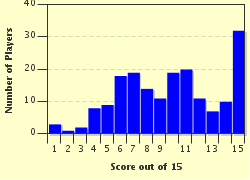Quiz Answer Key and Fun Facts
1. I thought it would be a good idea to start off on a cheery note with an old Music Hall song. In "the Laughing Policeman" by Charles Penrose we are told to "Shake him by his fat old hand, And give him half a crown". How much would "half a crown" be worth in modern coinage?
2. Doris Day's songs from the 1953 musical "Calamity Jane" were enduringly popular, especially "The Deadwood Stage" with its "Whip crackaway" chorus. Which wild west character whose "Gun has more than 27 notches" is mentioned in one of the verses of the song?
3. In the late 1940s there was a classic series of children's stories produced with Sparky as the central character. The most famous is "Sparky and the Magic Piano" but my question is about "Sparky's Magic Echo" in which he can no longer sing because he has lost his echo. Who finds his "voice" for him?
4. The voices in Sparky stories were often familiar ones from Disney or Warner Brothers cartoons. However, there is one voice artist who was a legend in the film industry. "I Taut I Taw a Puddy Tat" was on nearly every week in the 50s and 60s with Sylvester and Tweetypie, two of this artist's best known characters. He was known as "The Man of a Thousand Voices" - who was he?
5. We go from one legend to another. Burl Ives was one of those performers who was on children's radio often because there were several songs of his that they loved. In his most requested song, "Big Rock Candy Mountain", what is flowing from the fountain?
6. Some children's songs that were popular came from poems set to music. "The Pied Piper of Hamelin" was one but the most played in Britain was "The Owl and the Pussycat" sung by Elton Hayes. The writer is known for his "nonsense" poems - who was he?
7. This wasn't the only poetry set to music to give it added attraction for children. In 1941, at the age of nine years, Ann Stephens, a child actress, recorded some of A.A. Milne's poems written for Christopher Robin, his son. "They're changing Guards at Buckingham Palace" tells the story of his visit to London with his nurse, Alice, who is "marrying one of the guards". What does she tell him that one of the sergeants looks after for the sentries?
8. In 1939 MGM made "The Wizard of Oz", taking the story from a book by L Frank Baum. During her trip to Oz Dorothy meets three strange characters who join her - The Tin Man, The Scarecrow and The Cowardly Lion. She sings "We're off to see the Wizard" with them. With which character does she sing it first as a duet?
9. "Snow White and the Seven Dwarfs", Disney's first full length animated feature film in 1937, produced some popular childrens' songs. Most requested was "Heigh Ho" sung by the Dwarfs. However, which of the Dwarfs did not sing because he was mute?
10. Another childrens' favourite from the 1930s was Shirley Temple. Her songs were still heard regularly on radio and most wanted was "Animal Crackers in my Soup". In the song which two animals "loop the loop"?
11. "Who squeezed toothpaste round the hall?
Who put soot in the baby's ball?
Who drew things on the garden wall?"
Who did these awful things in Terry Scott's comic song?
12. Always a great attraction for children are speeded up voices. David Seville and the Chipmunks had several recordings that were often played. The Chipmunks high-pitched voices did the singing while David Seville tried to stay in control. In "Ragtime Cowboy Joe" which of the Chipmunks is going crazy with a six-gun and charging about on a horse?
13. Another favourite which contained speeded up voices was "Windmill in Old Amsterdam" by Ronnie Hilton accompanied by high-pitched mice. According to the song what did the mice have as footwear?
14. Spike Jones came up with all sorts of strange noises on his recordings. Children love the lunacy and anarchy of it all. "Ol' Maconald", "Cocktails for Two", "William Tell Overture" and many others would turn up in the "Spike Jones style" on "Children's Favourites". What was the name of his accompanying band?
15. "His back is brawny and his brain is weak,
He's just plain stupid with a stubborn streak"
Which animal was being referred to in the song "Swinging on a Star" by Bing Crosby?
Source: Author
baker13
This quiz was reviewed by FunTrivia editor
agony before going online.
Any errors found in FunTrivia content are routinely corrected through our feedback system.

